
After Osaka, where we landed and spent our first three days in Japan, we had our first Shinkansen ride to Kyoto (only 14 minutes to travel about 60 kilometers). Our first impression when stepping foot in Kyoto: the city is way more active and crowded (although not overcrowded) than Osaka and has a totally different feeling.
One major difference between the two cities is that Osaka has three big train stations that are separated by ten to fifteen minutes walking, while Kyoto has one huge station for all services (Shinkansen, JR, local trains…).
Kyoto also feels way more like a business city, with a lot more salary women and men hurrying to and from the station.
As this was our first visit of Kyoto, we visited famous places and must-sees, but we also looked for quieter places based on our specific interests. A good mix to discover several sides of this city, which has way more to offer than just the few overcrowded places you always see on social networks.
Hi there! I’m a French-speaking writer and blogger and most of my content is in French. Please leave a comment to let me know if you enjoy my articles in English and would like me to continue translating my original posts!
Day 1 – First steps in Kyoto
Kimono rental
We booked a kimono rental with📍 Okamoto for our first day in Kyoto. They have several kimono (and other Japanese traditional clothes) rental shops in Kyoto, some of them near the most famous places in the city, but since we’re not into crowded places we chose a location in a quieter area, which was the one on Emion hotel premices.
We made our reservation online in advance and chose the earlier time available (10 AM) so we could enjoy our outfits all day long. It took about one hour for us to choose the clothes then get dressed (I also had my hair done). It was killing hot that day (up to 31° C) but kimono felt really nice and we didn’t get sweaty thanks to the underlayers, in a fabric made to absorb humidity without feeling damp. My male partner, who hates heat even more than I do, was even happy to wear a yukata, as he admitted it felt more breathable than usual western men clothes!
I really liked the experience of being dressed, discovering all the layers that make up for this traditional outfit. The women dressing us up were really fast and a bit firm in their instructions, which was funny because it felt so different from the general attitude of Japanese people. It didn’t feel agressive or disrespectful at all, I just think they have to be very efficient in order to be on time for all reservations, so they cannot make this a chill moment. (So you’re warned, better have yourself a coffee before your appointment so you can keep up ahah.)
And wandering with these clothes on was also a great experience. I was a bit afraid at first that Japanese people could see this as a lack of respect for their traditions, but it really felt otherwise: a lot of people in the street were fondly smiling and also complimenting, even sometimes respectfully bowing. It really gave me the impression that a lot of Japanese people are happy to see foreigners embrace their traditions.
We wore our kimono and yukata all day long, and gave them back around 5 or 6 PM. There was an option to keep the clothes until the evening, in which case your hotel handles the return to the rental shop (I even think there was no additional fee, but it required a deposit).
Toji temple
Our first visit was Toji temple, a big Buddhist temple with several halls and a pagoda, in a park with a pond. A perfect spot for pictures. Inside the hall, we could see tall golden statues, similar to the ones we saw in Nara the day before.

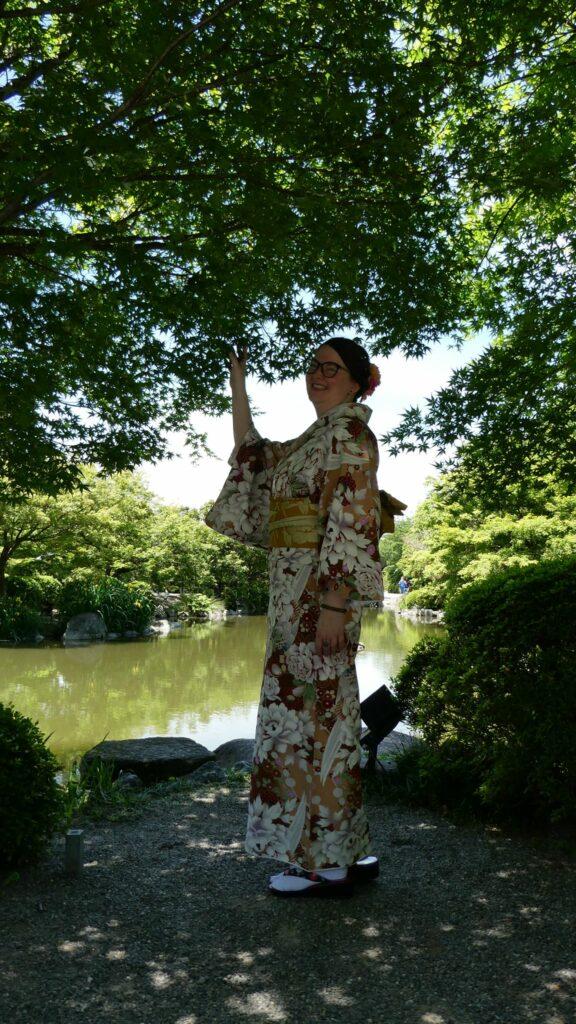

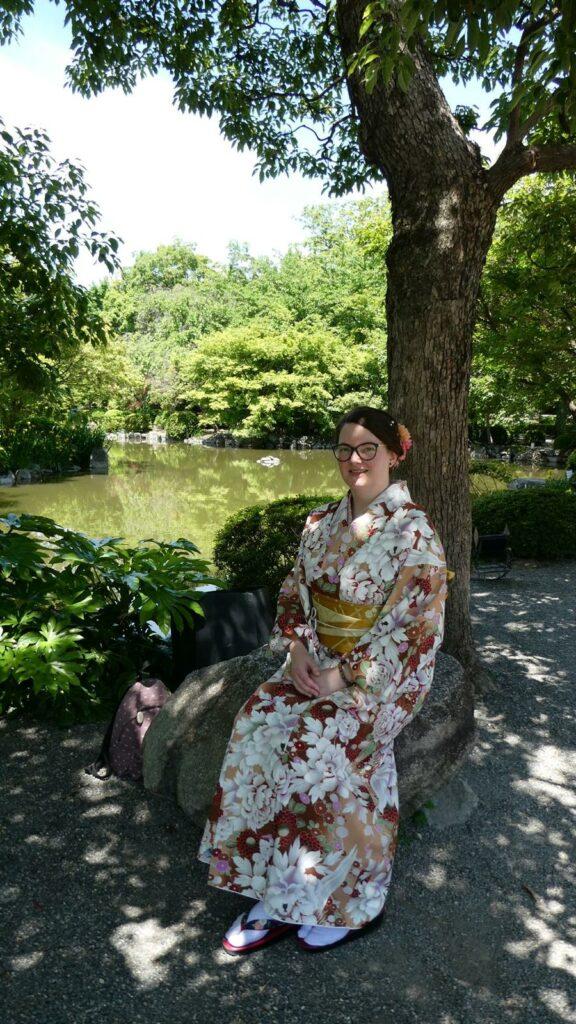
Higashi Honganji and Shoseien gardens
Around noon, we tried to escape the heat by wandering in a mall, in search for lunch, and we decided to have our first kaiten sushi (conveyor belt sushi). There was only one client apart from us, so instead of leaving sushi on the conveyor belt for a very long time and letting it loose its freshness, they were only making custom orders (with a tablet, so fear not if you’re not confident ordering orally). As any kaitenzushi we tried in Japan, the food was amazing and so much better than what we have in Europe, for a way lower price.
📍Kaiten sushi Uogashi in AEON Mall Kyoto
After a good meal, some time in the gachapon shop of the mall, and going to the toilets with a kimono (the experience was way easier than I expected), we headed to Higashi Honganji Buddhist temple. After passing a gorgeous gate, we discovered a hall that was pretty different from the usual setting, with a praying space way bigger than the equivalent of the altar (it’s usually the other way around).
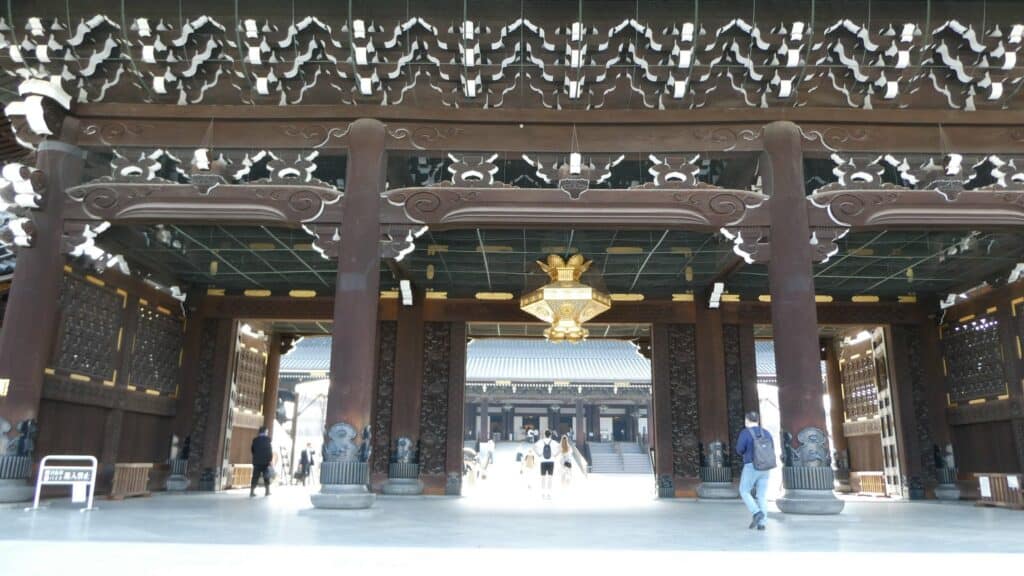
Right next to it, we visited Shoseien gardens, a small but quiet place, great for wandering and for pictures. We visited at the least interesting time, regarding flora, but I think it must be amazing during blossom season, or with fall colors (momiji).
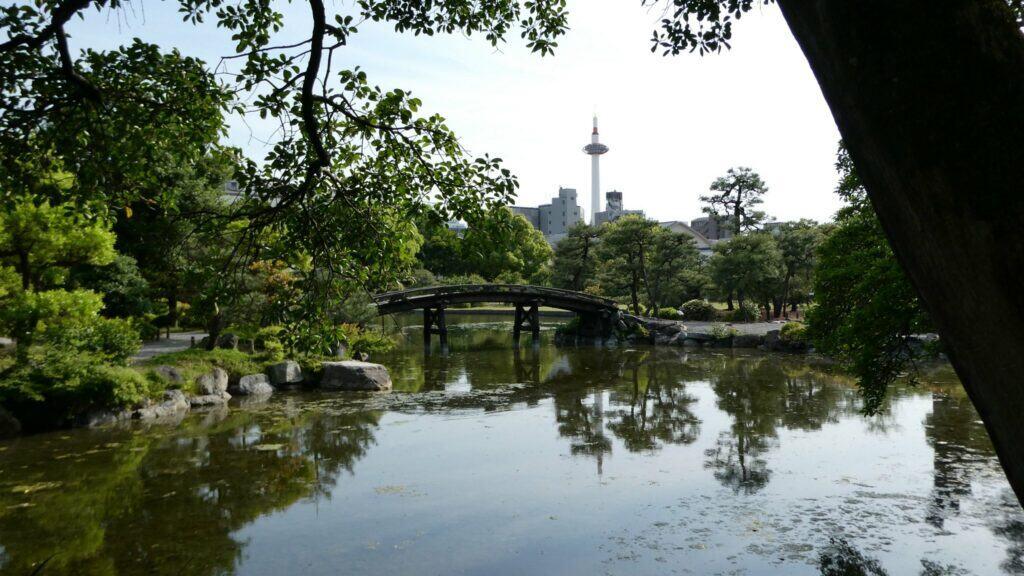

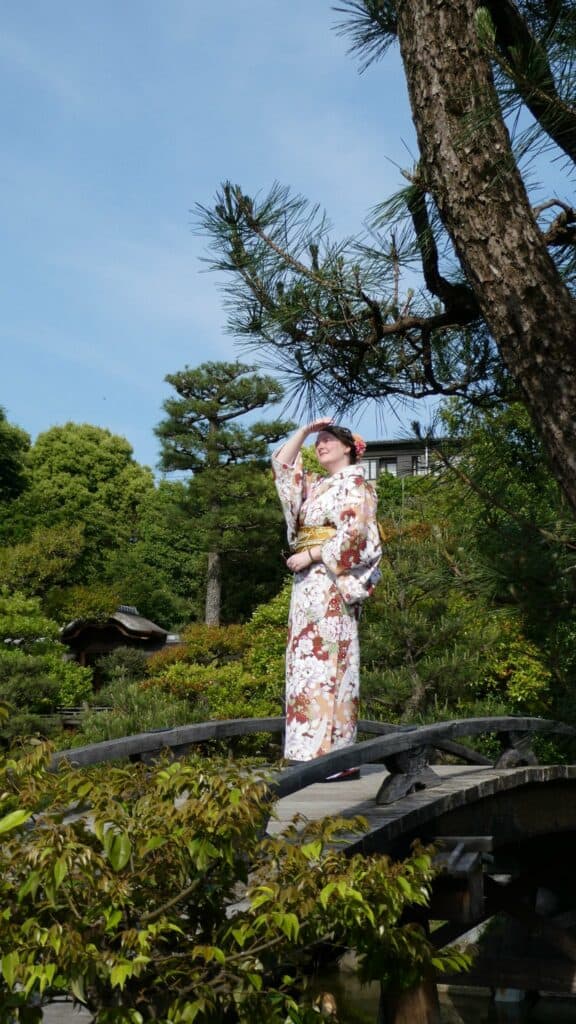

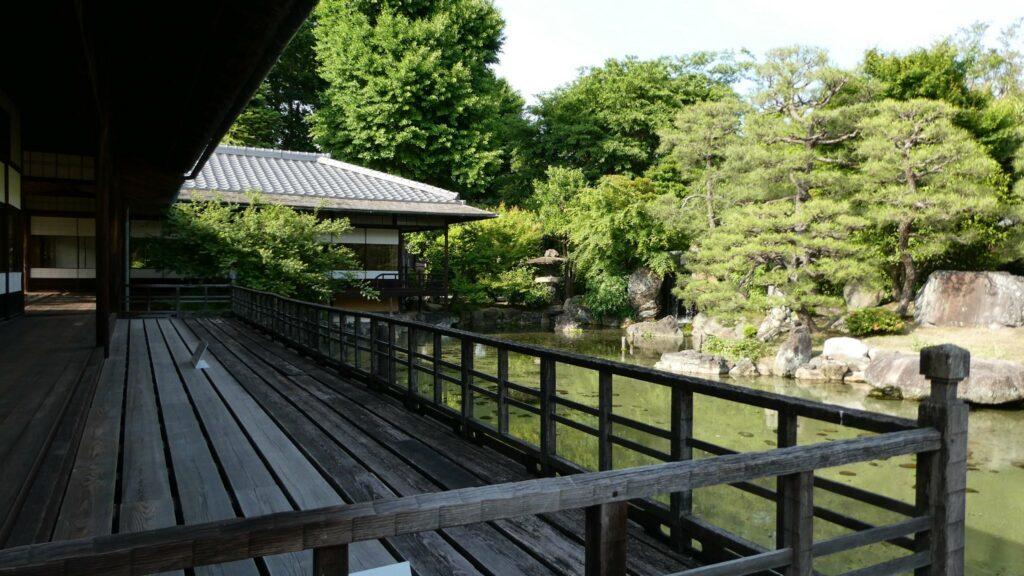
Our first matcha in Japan
We gave back our kimono and took the opportunity to have a matcha tea with a Japanese sweet (wagashi, traditionally served with matcha to balance its bitterness) at Emion hotel. Kyoto is the place to have matcha, since it’s one of the cities which is famous for this variety of tea.
Wagashi is not for everyone, and personally I enjoy the bitterness of matcha so I don’t feel like I need to “dilute” it with something sweet, but I think this combo will appeal to most people. Japanese people usually don’t like overly sugary sweets (apart from wagashi, it seemed to me that everything was way less sugary than in the West), but wagashi is really on the sweet side. On the other hand, it’s really small, so it compensates for the sugar ratio!
Some ramen in Kyoto
To conclude this first day in Kyoto, we went for ramen at📍 Sankyo, a good spot for classic, fast ramen, a walking distance from Kyoto station and from many hotels in the area.
Day 2 – Fushimi sake district and Fushimi Inari shrine
My partner and I love distilleries (although we especially knew of whisky distilleries at the time), so we were super curious to know more about saké (nihonshuu in Japanese). Kyoto hosts the Fushimi saké district, an area where you can visit, taste and buy products related to the most famous Japanese alcoholic product.
We really enjoyed the place and consider going back when we get another chance to visit Kyoto. To this day, we still regret not buying one of the saké bottles we loves so much, because we thought we would find it later, elsewhere, eventually. Big mistake! When in Japan, always buy something you really want as soon as you find it, as you might not see it again.
Fushimi saké district
It’s situated about ten minutes by train from Kyoto Central station. A few steps into the neighborhood and we can already see the silos of some distillery. The main street is beautiful, with the wooden houses that make you feel like you stepped back in time. Before our first glasses, we visited Choken-ji, a small but quiet and green temple dedicated to saké, and particularly to the local water source, making for one of the base ingredients of the famous drink.
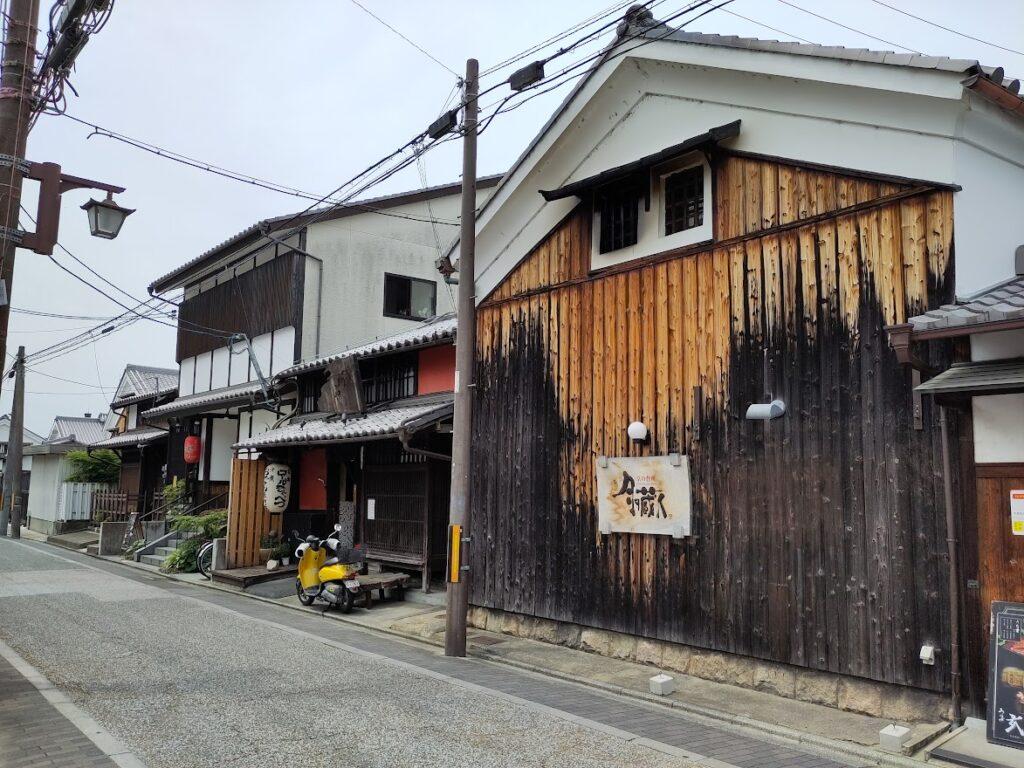
Gekkeikan
Gekkeikan is a distillery, a museum about saké and a research center. For only 600 yen (around 3 or 4 €)*, you can learn more about saké and enjoy 3 sakés after the museum (as in many places, you get coins and use them with automatic dispensers). You even receive a souvenir saké cup to take with you.
This is where we first discovered that saké as we know it in the West has hardly anything to do with what’s available in Japan. Especially, the fact that saké comes in dry, slightly dry, sweet… varieties was totally new to us.
It’s also good to know that Gekkeikan exports a lot (I can find their flagship saké easily in Belgium in Asian supermarkets).
Yume Hyakushu café (sake tasting sets)
A few minutes from Gekkeikan, we head to Yume Hyakushu, a place to enjoy many different saké, individually or in premade tasting sets of three. With a bit of help from Google translate, we managed to communicate our preferences and get a very good recommendation for a tasting set. This is where we discovered the best saké we’ve tasted so far, “Tsuki no Katsura” (middle one on the picture).

Sakagura Koji saké ramen 🤩🤩🤩
We ate lots of ramen in Japan, and they were all amazing. But this one time was a genuine foodgasm that lives rent free in our heads (next to the nigiri sushi from Toyosu market in Tokyo, but that’s part of another article).
📍Sakagura Koji is a kind of food court with several counters, where you can drink saké but also eat several types of dishes, like ramen, gyoza, sushi… Each counter has its own menu, but there is also a common menu to all of them, so that you can order saké or bites in addition to what each place offers.
We went there for Monsen, a saké ramen restaurant. And you won’t believe this… they had one with the very saké we just fell in love with at the saké tasting in Yume Hyakushu! It was to die for, the taste of saké in the broth was incredible.
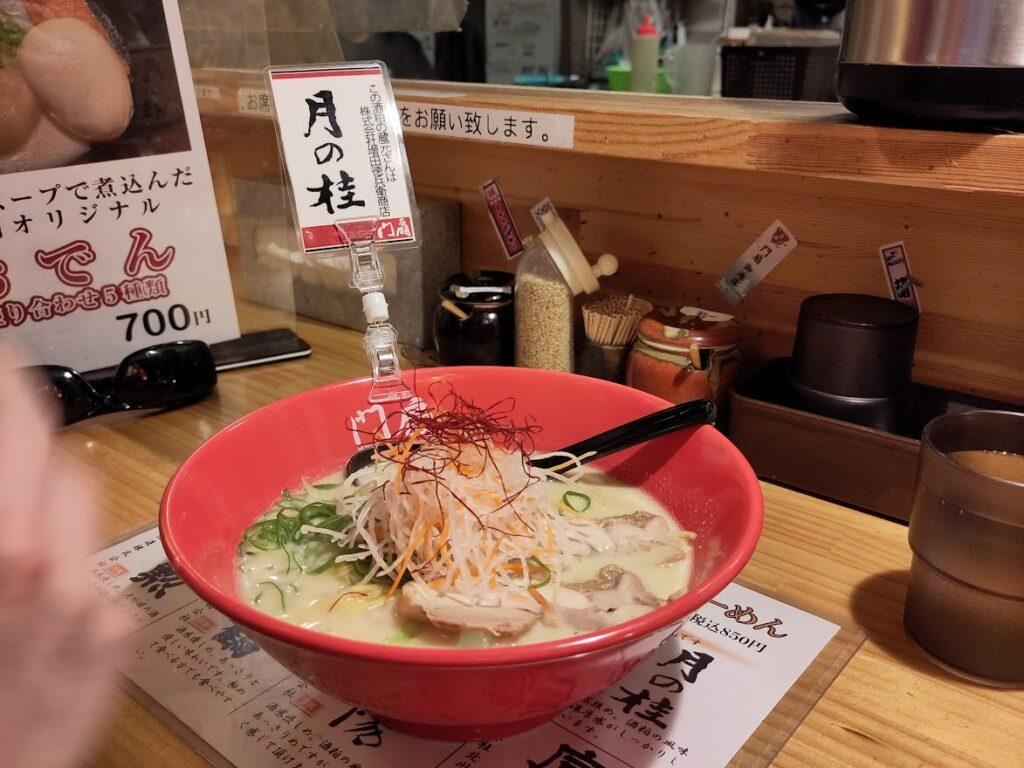
Ginjo Shubo Aburacho (saké shop)
Of course you’ll find at least one shop selling saké in this kind of neighborhood! This shop also offers saké tastings (paid), so you can try before you buy a whole bottle, but when we visited we felt slightly drunk already with our morning tastings and the saké ramen, so we didn’t push further.
Gokonomiya jinja
Leaving Fushimi saké district to go back to the train station, we randomly discovered a beautiful temple with a stone torii: Gokonomiya.
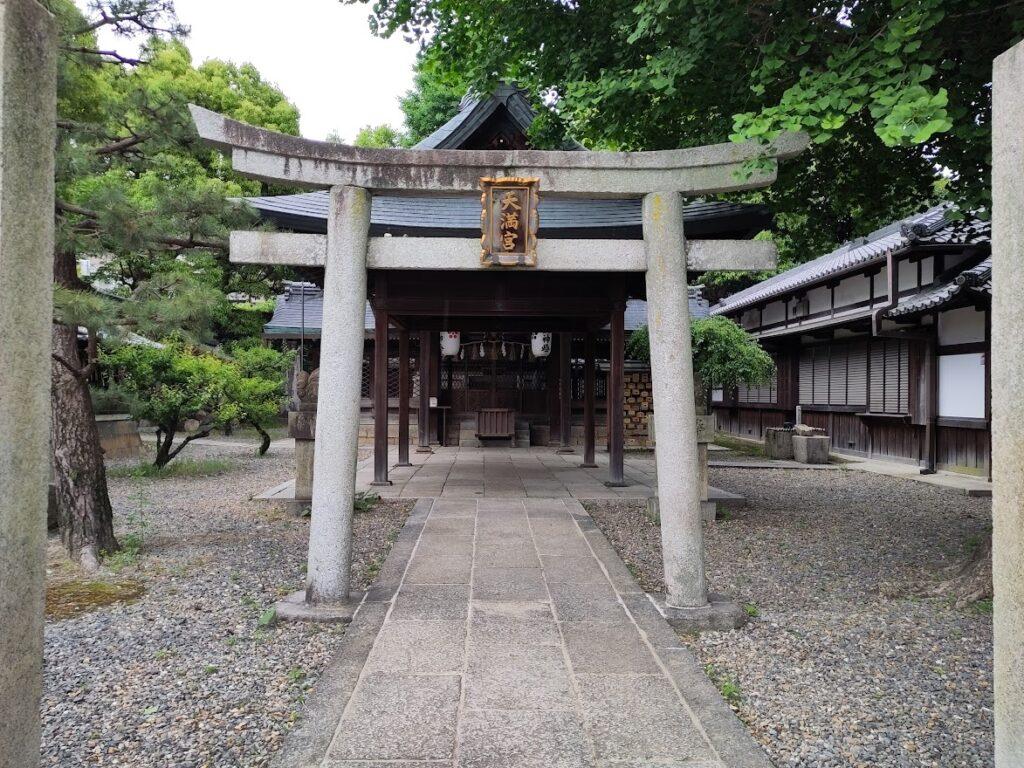
Fishimi Inari Shrine🤩🤩🤩
This was probably the worst day regarding the weather, as it started pouring rain like hell, so much that we had to go back to our hotel and change before our next visit.
However, we didn’t change our plans and went for an evening visit of Fushimi Inari, around 5.30 PM. This way, we could see it in the daylight, then at night. We heard it was gorgeous in the dark, but also way less crowded. Fushimi Inari and its “one thousand torii” is probably the most famous place of Kyoto for tourists, which means it gets really crowded and a lot of people are stopping regularly for an Instagram photoshoot.
Although the weather was awful and it was already late in the afternoon, there were still a lot of people, but when you go further than the first section it gets quieter. We went for the full hike to mount Inari (232 meters high, almost all stairs…).
As dusk settled, the atmosphere changes completely, reinforced by the mist of the rain. I really loved it, although it was physically challenging, and would like to go back and do the same in daylight. There were so many details to enjoy that I’m sure you can visit several times without getting bored.
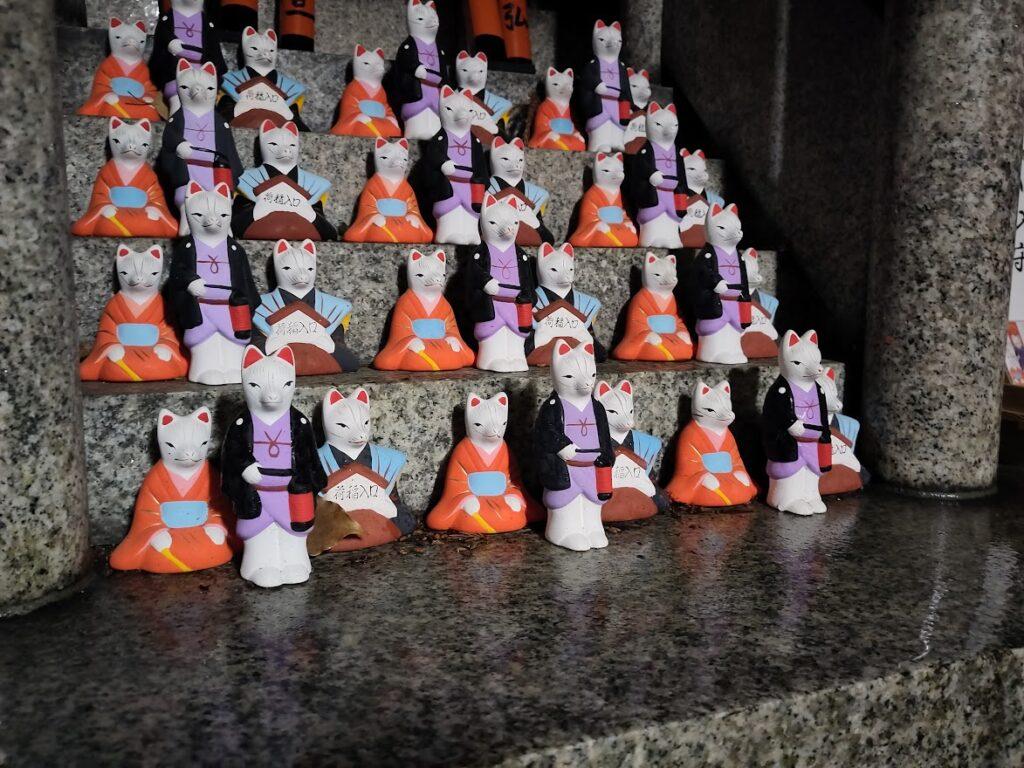
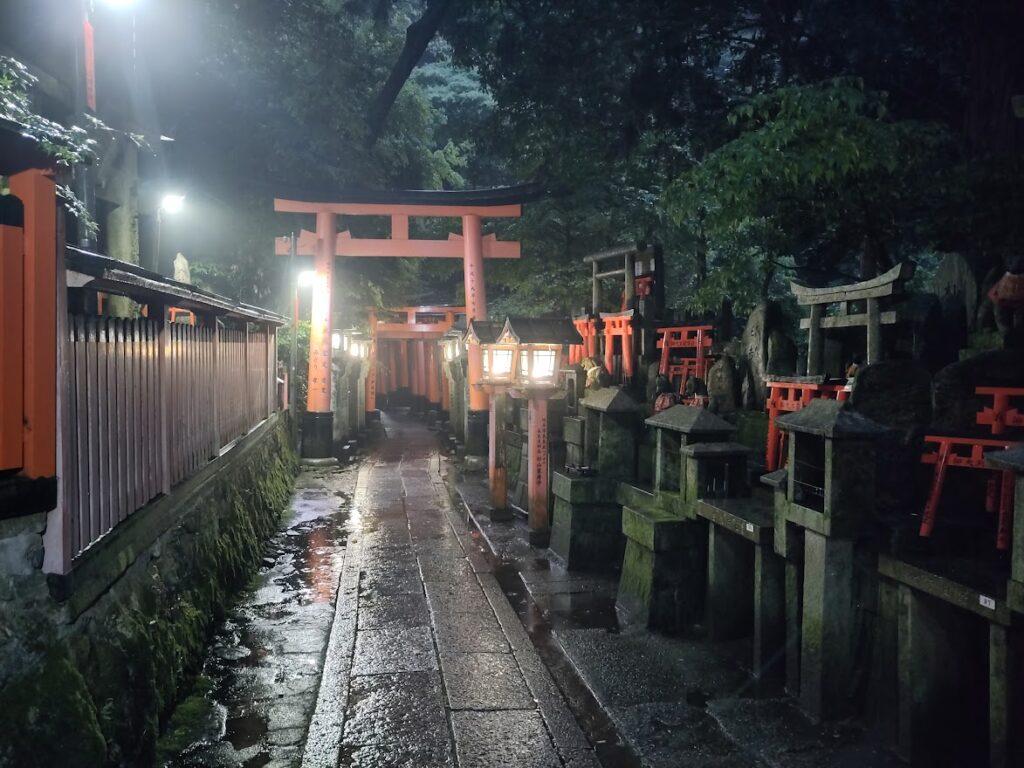
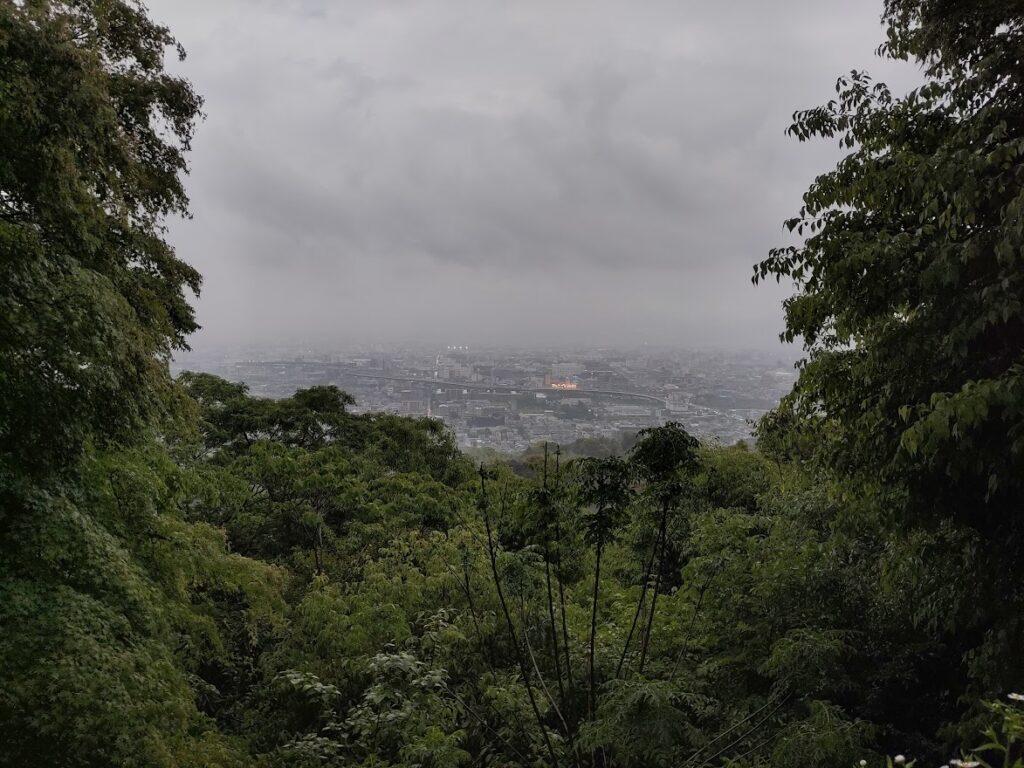

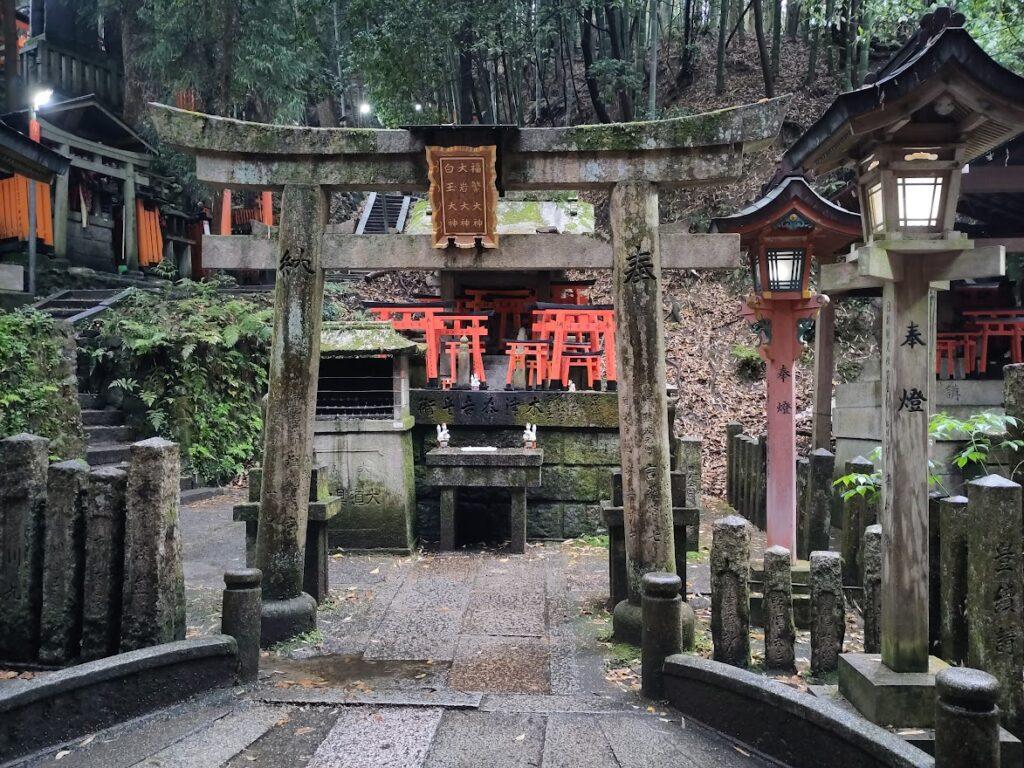
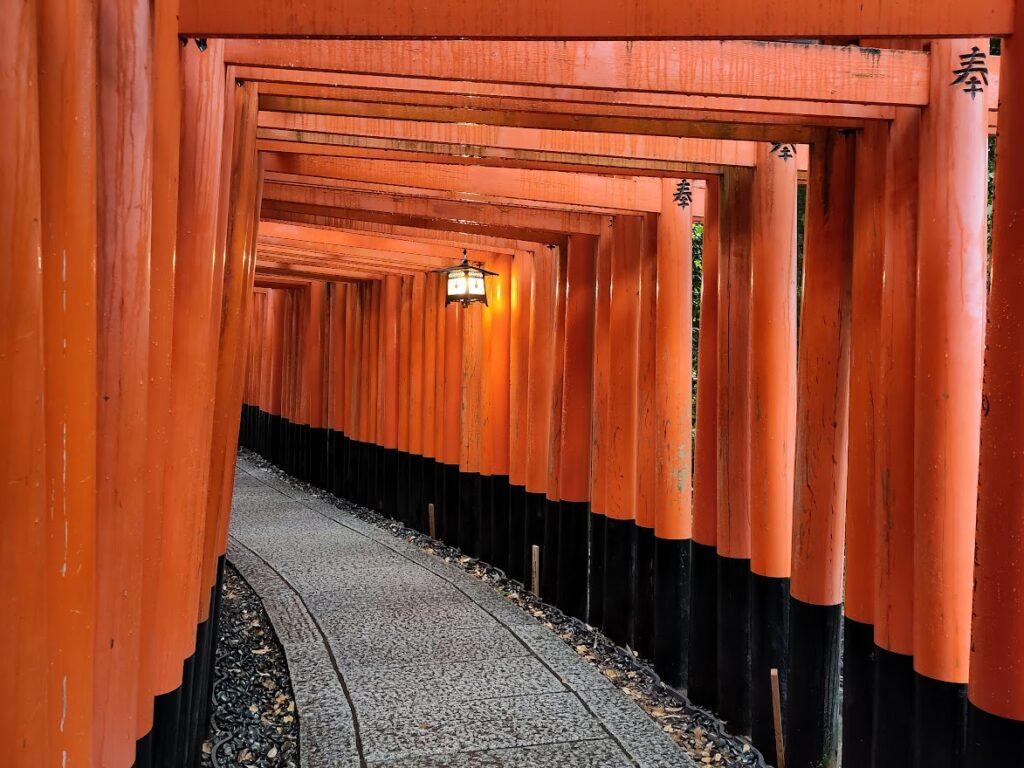

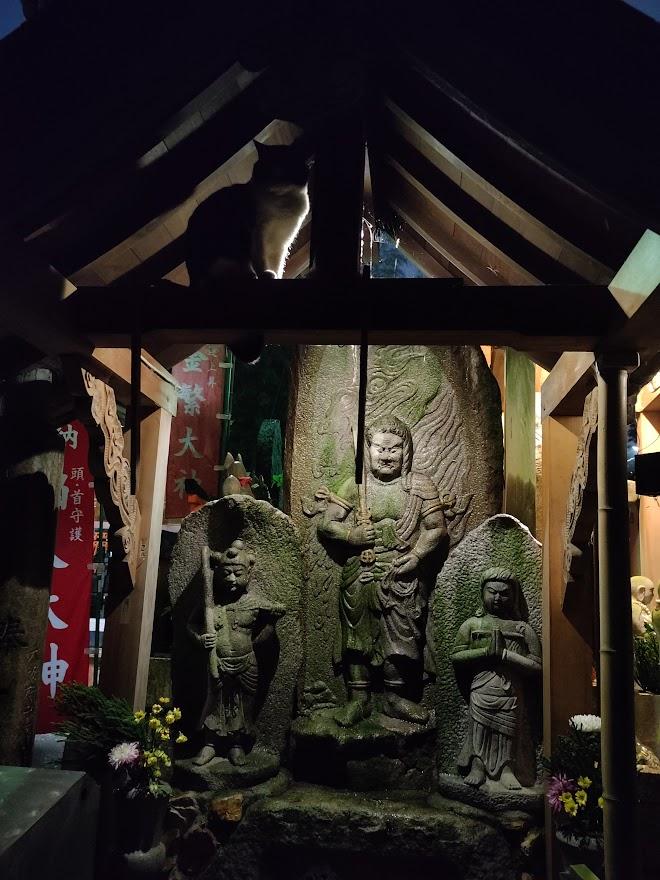
We spent almost three hours there (spoiler: we’ll go back later the same week). All in all, a great day!
Day 3 – Arashiyama, Kinaku-ji and Uji
Arashiyama
This is another of the “must see” places that you’ll find in every guide about Kyoto. It’s most known for it’s bamboo forest and its picturesque bridge. We started with the visit of Tenryu-ji, a temple with a garden, a pond and walking paths. There is an additional fee to visit the temple, which we didn’t do.
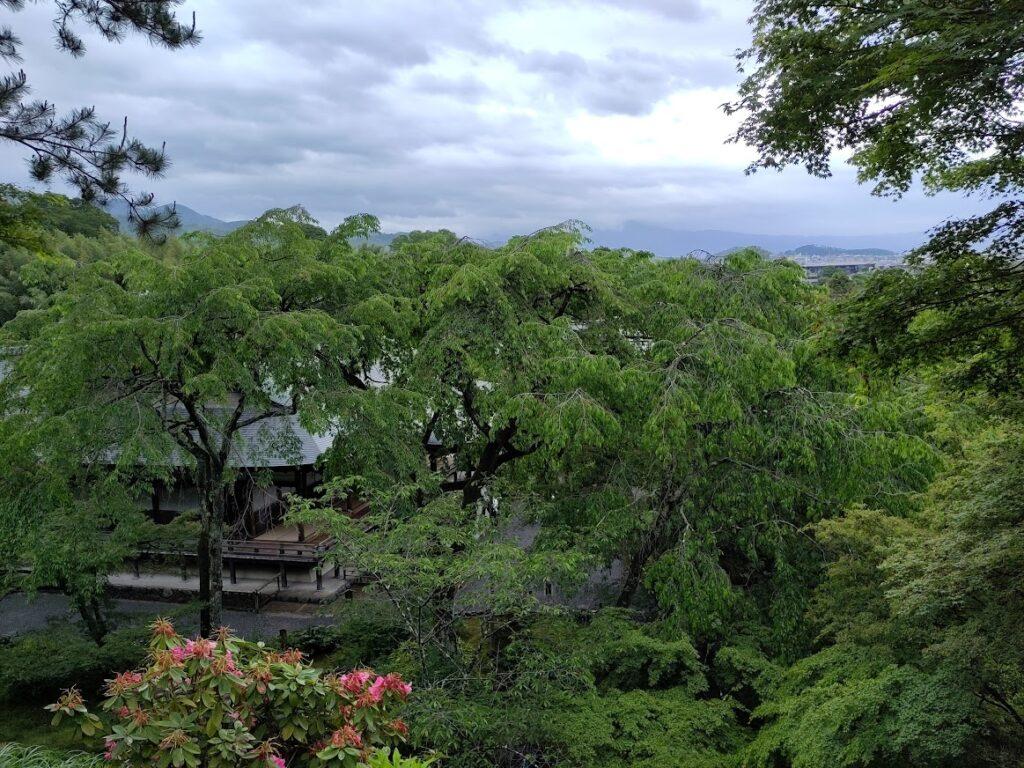
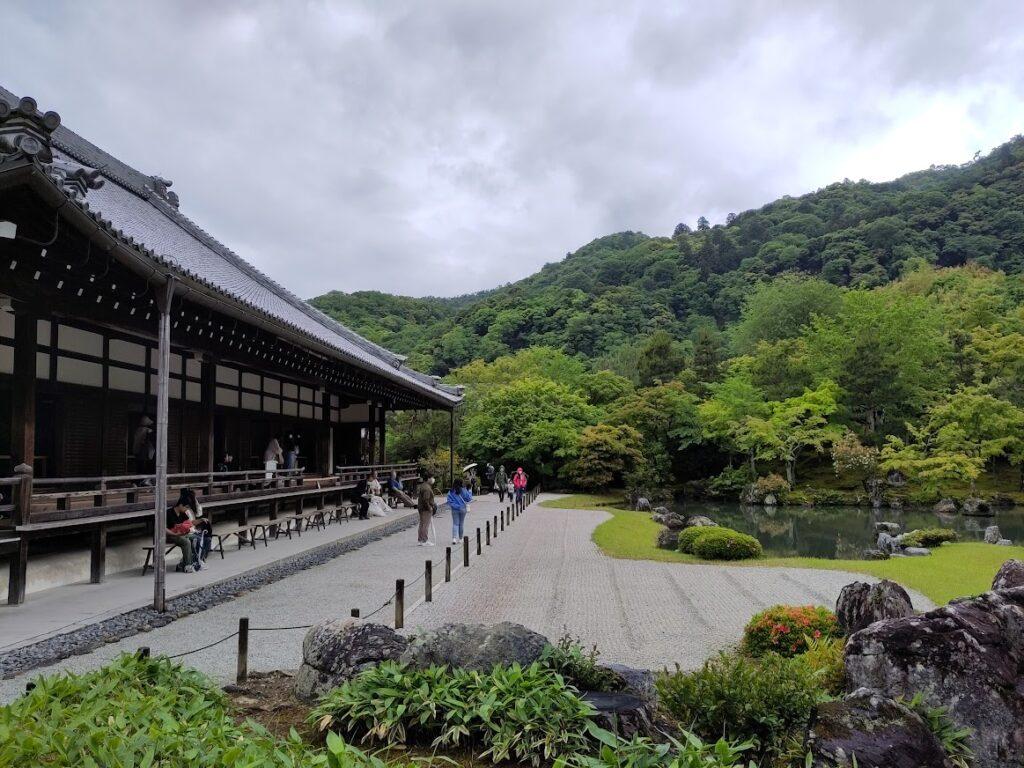
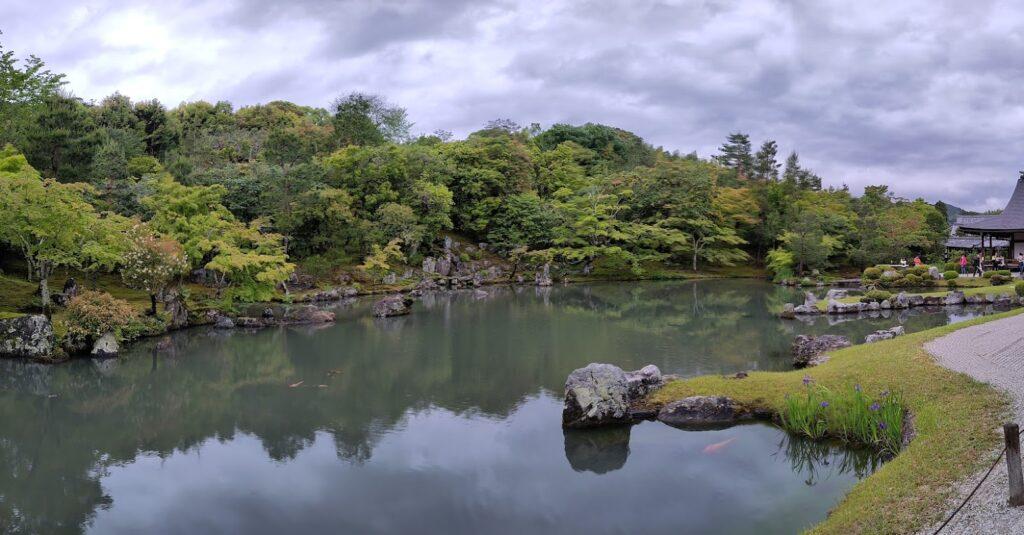
Next step was the bamboo forest, and for me it was pretty disappointing as it was nothing like what pictures always show you: it was not relaxing at all, it was overcrowded. We went on a Sunday at 10 AM and it was a mix of tourists and students in field trip. Because of the crowd, it didn’t impress me that much.
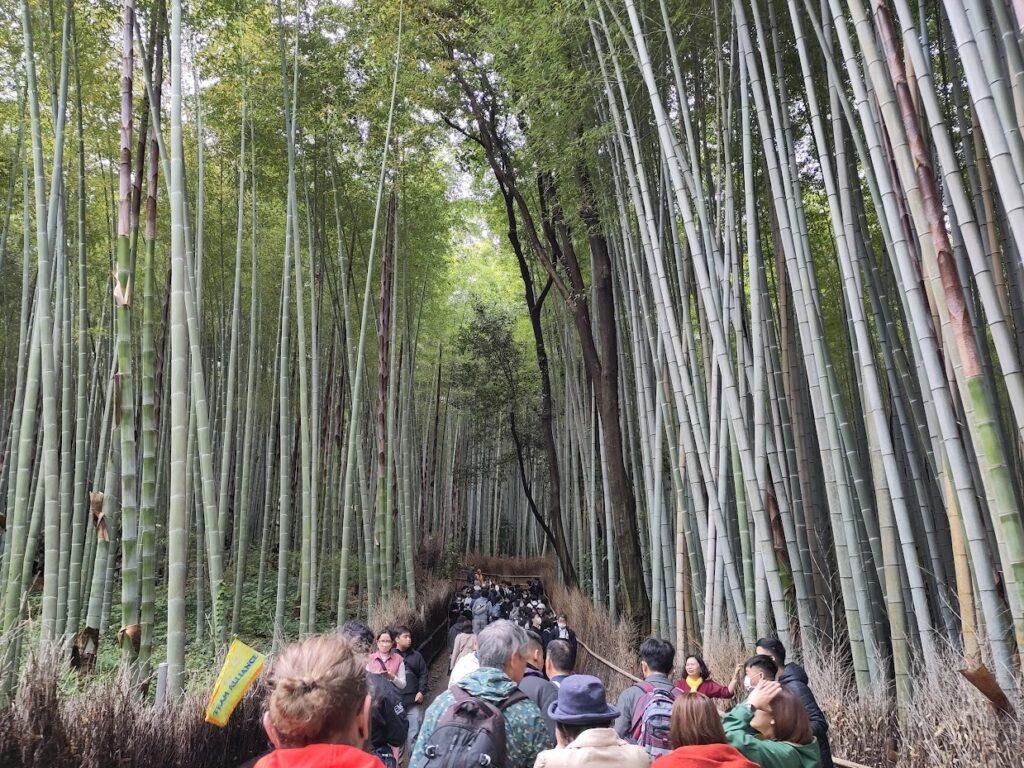
Out of the bamboo forest, we walked along the river in direction of the city center. The water has a silky look and the vegetation around was super lush, which made it all really beautiful. A nice breath after the crowd. I think that was my favorite part of the whole Arashiyama area.

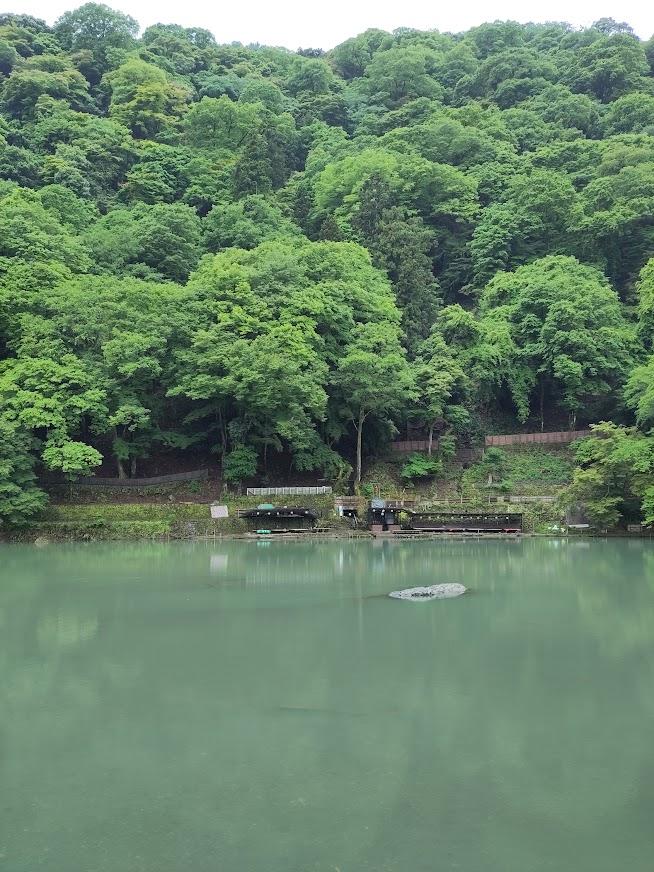
The crowds were waiting for us near the famous bridge of Arashiyama and the city center, cute but full of tourists. It was 10.45 AM and queues were already formed in front of most restaurants (apart from the few ones that required booking in advance and formal attire).
We ended up eating some street food on our way to the station, roasted sweet potatoes and dango.
Overall, Arashiyama was really not for me, and I feel fooled by all the pictures and videos I’ve seen online. If you want to go, I strongly recommend to avoid weekends, and probably go as early as possible.
Kinkaku-ji, the golden pavilion
With the bus, we headed to Kinkaku-ji (the usual name of Rokuon-ji). We were a bit scared of taking the bus, but it turned out as easy as using the train in Japan. I talk more about it in my dedicated post about everything you should know for your first trip to Japan.
Kinkaki-ji is quite small, you can see it from all angles but the tour is quickly done.

Before leaving, you can have matcha (hot or cold) in a traditional tea house with a garden view, and we really enjoyed it. The tea house was really quiet and it felt like a nice break after the crowds.
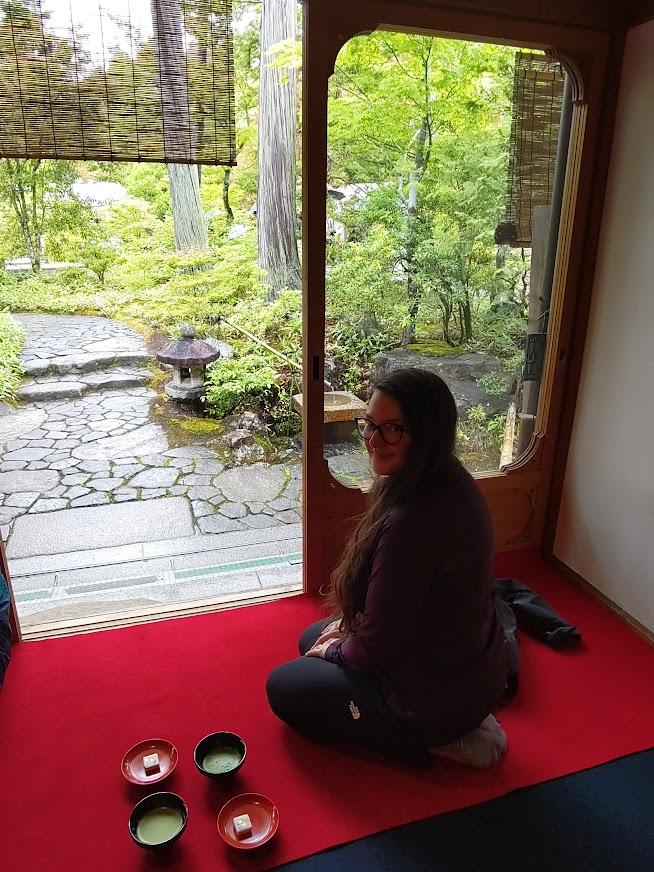
Uji, the matcha district
The day was still young so we quickly went back to the hotel (the perks of visiting a country with such efficient public transportation!) to decide on our next visit, as we already did everything on the planning that day. Looking for a good place to buy matcha, we discovered Uji, the matcha district in Kyoto.
Right in front of the station, we came across a statue dedicated to Murasaki Shikibu’s The Genji’s tale, a major Japanese literary piece. Uji is the place where the first ten chapters of the story take place.

In Uji, you can also visit Byodo-in, a big temple designated as a Unesco World Heritage and that you can see on 10 yen coins. It’s known for its two phoenixes and the sculptures of characters floating on clouds. It also has a museum.
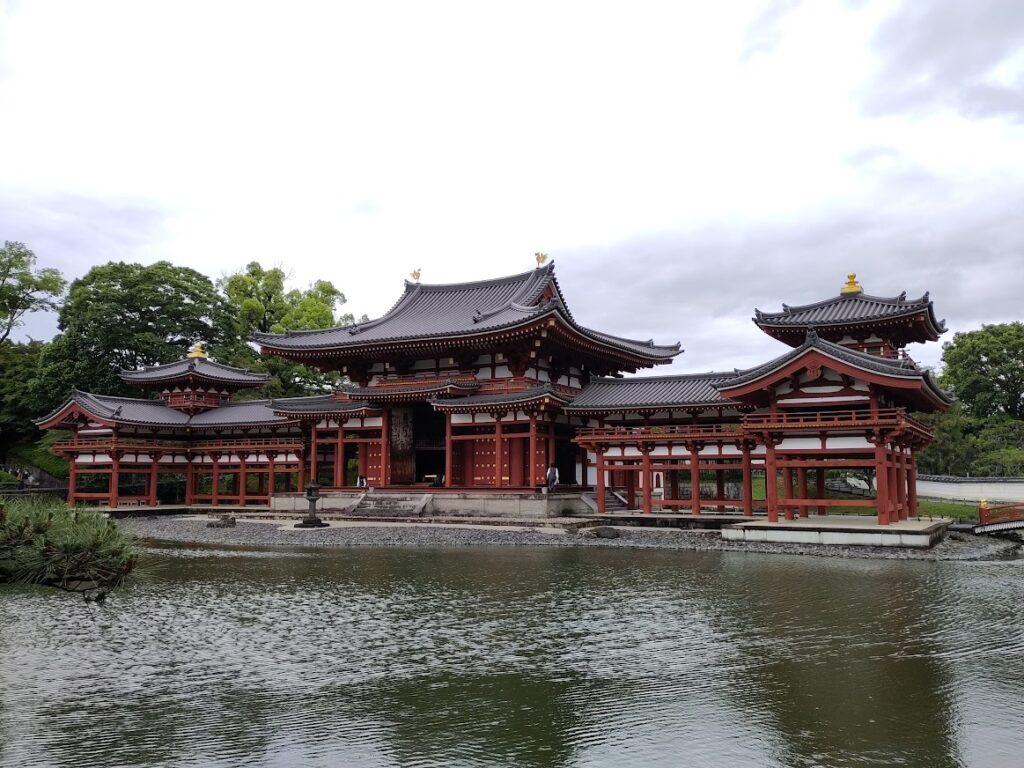
After this visit, we went to the “matcha street”, with many shops selling tea and matcha. However, we found it difficult to know where to buy and what to buy, it was not easy getting advice about the products or knowing what was really good quality, because surprisingly shop staff didn’t really talk even basic English. You’d better know what you’re looking for ahead, or prepare a few sentences in advance.
The match soba restaurant we spotted earlier was closed, so instead we went to a supermarket nearby. In Japan, it’s all about local products, so this particular supermarket was selling match products that would not be found elsewhere.
Day 4 – Kyomizu-dera and surroundings
Kyomizu-dera and Yasaka Pagoda
This is probably the second most famous spot of Kyoto, after Fushimi Inari. We visited on a Monday, but it was still crowded with both tourists and students.
Kyomizu-dera is a temple on a hill and surrounded by trees, which makes it lovely, but it’s situated really close to the city center, which also makes it convenient for short stays in the city. Apart from the well know terrace, there are many paths where you can wander and many views to enjoy.
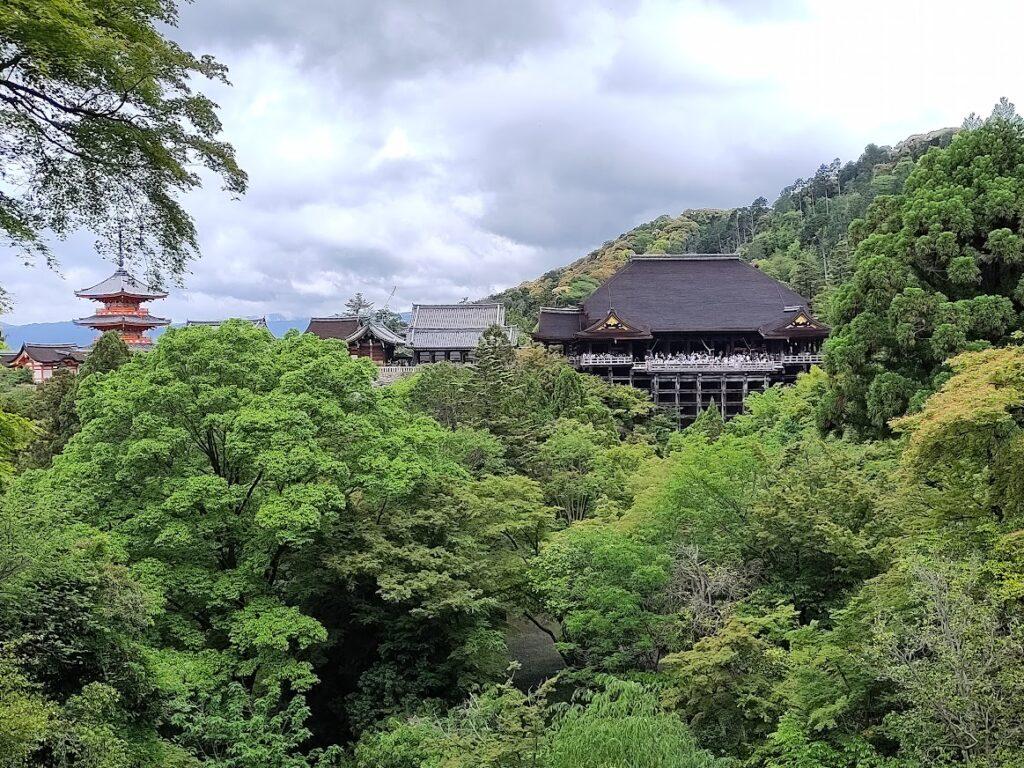


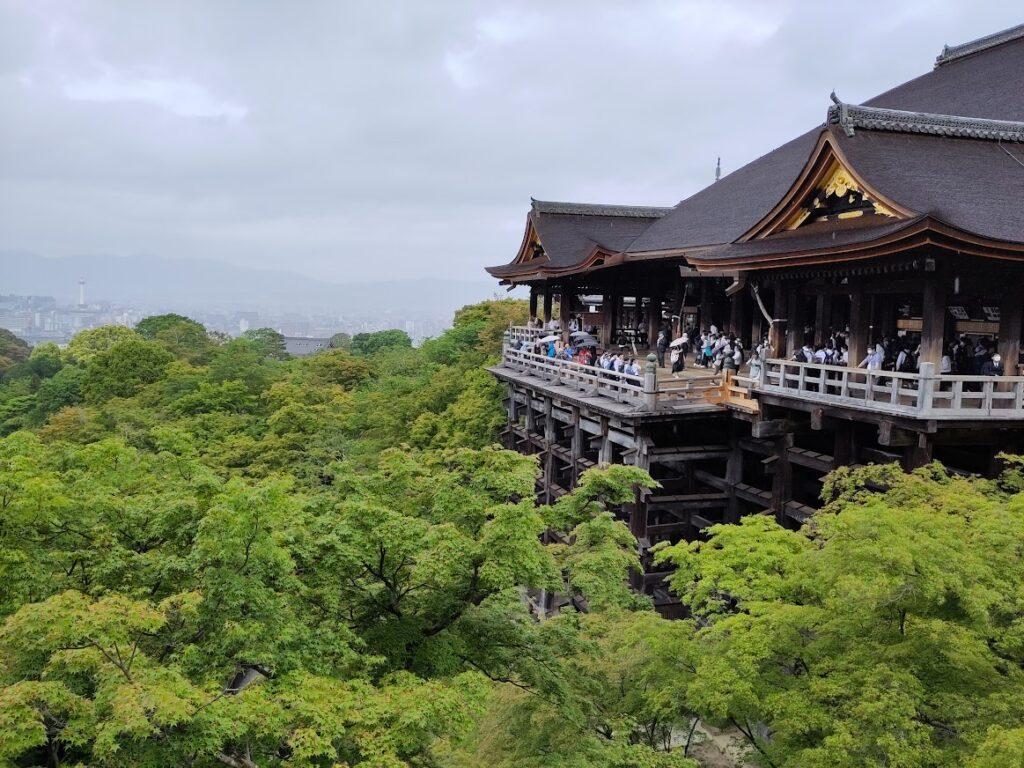
After Kyomizu-dera, we walked the iconic Sannenzaka and Ninenzaka streets. In Ninenzaka, you find a beautiful Starbucks coffee shop, nicely incorporated in the district and where you can enjoy your order on tatami (limited tatami spots available). You can also choose a window seating and enjoy the views on the street.
📍 Starbucks Ninenzaka Yasaka Chaya
We continued to Yasaka Pagoda, in my opinion not the most beautiful pagoda in Kyoto but it’s just again very convenient because it’s close to many other points of interest. It’s thus also a selfie and photoshoot spot, so prepare to queue if you want “the” shot.
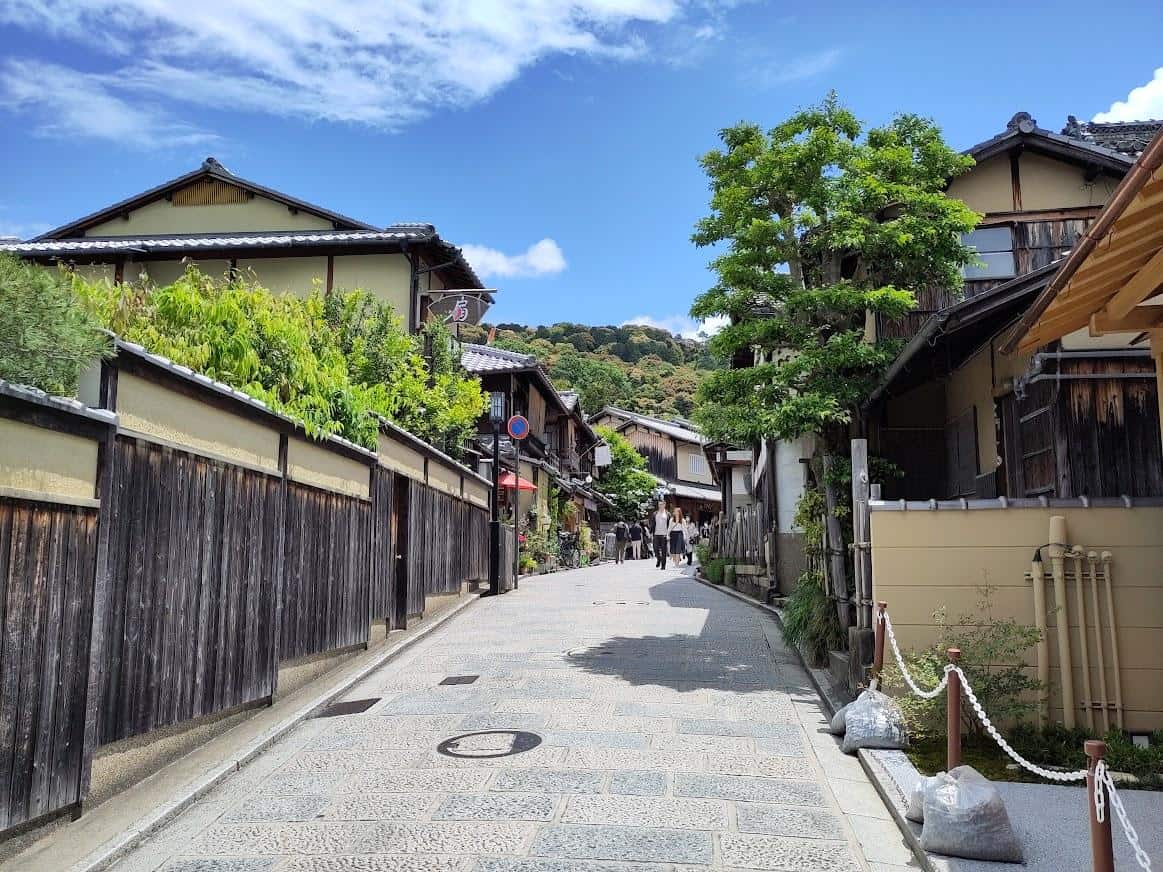
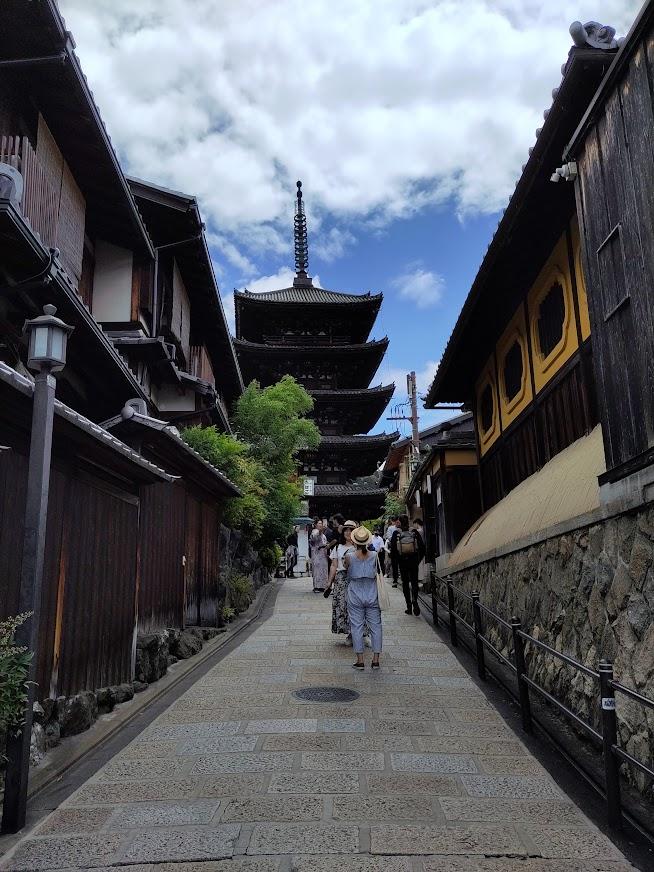

Nishiki market
From there, we headed to Nishiki market by foot. This market is know for its food stalls where you can grab different street foods. We tried a few things but nothing worth mentioning in our opinion. On the way there, we visited the temple Kennin-ji.
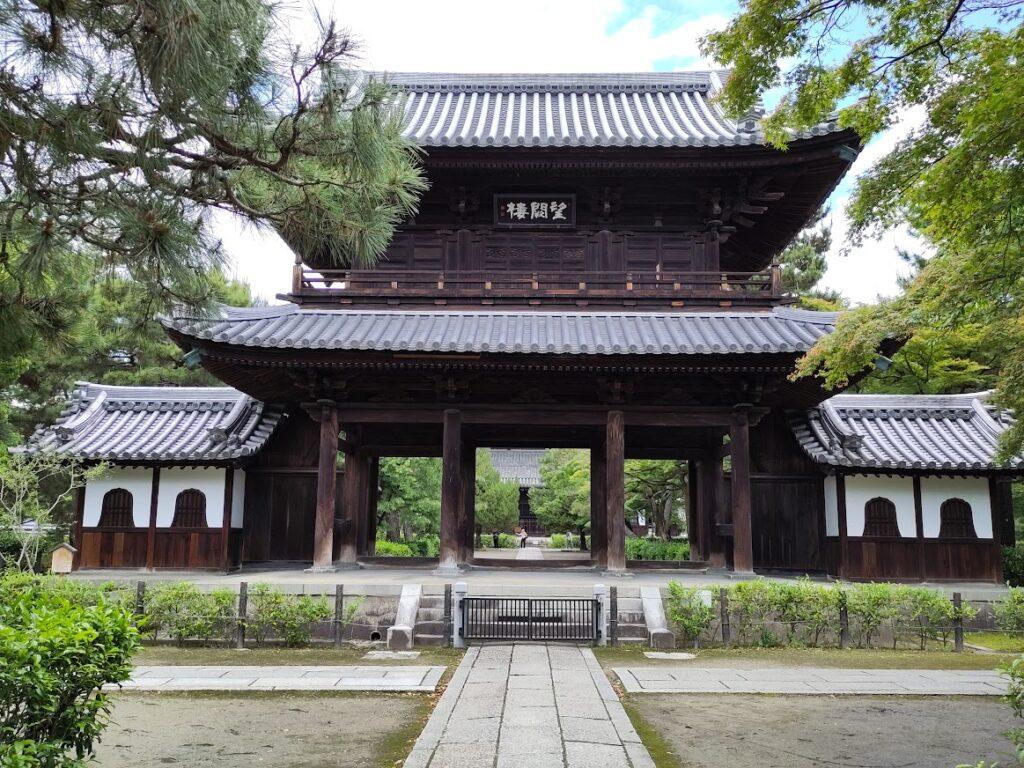
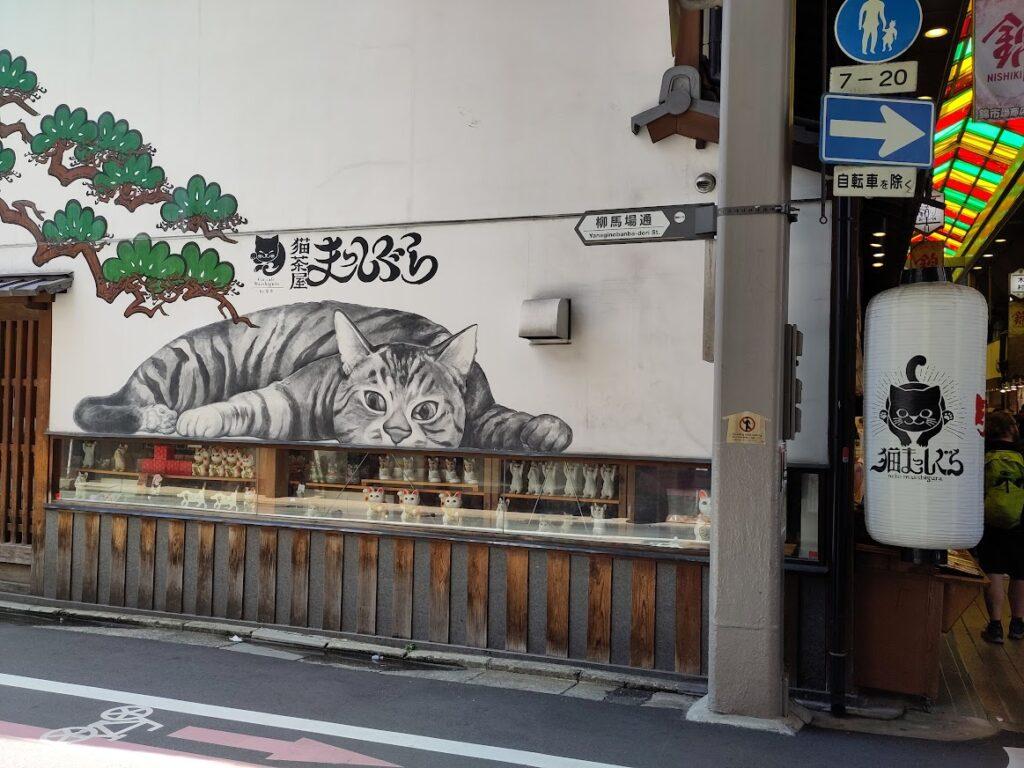
Nanaya🤩🤩🤩
After Nishiki, we walked to Nanaya, a shop dedicated to matcha products, like chocolates and cakes, but also offer soft serves that come in seven levels of matcha. As a matcha lover, I enjoyed their strongest one (my partner just couldn’t), but even their lightest one is really good for those who like it more subtle.

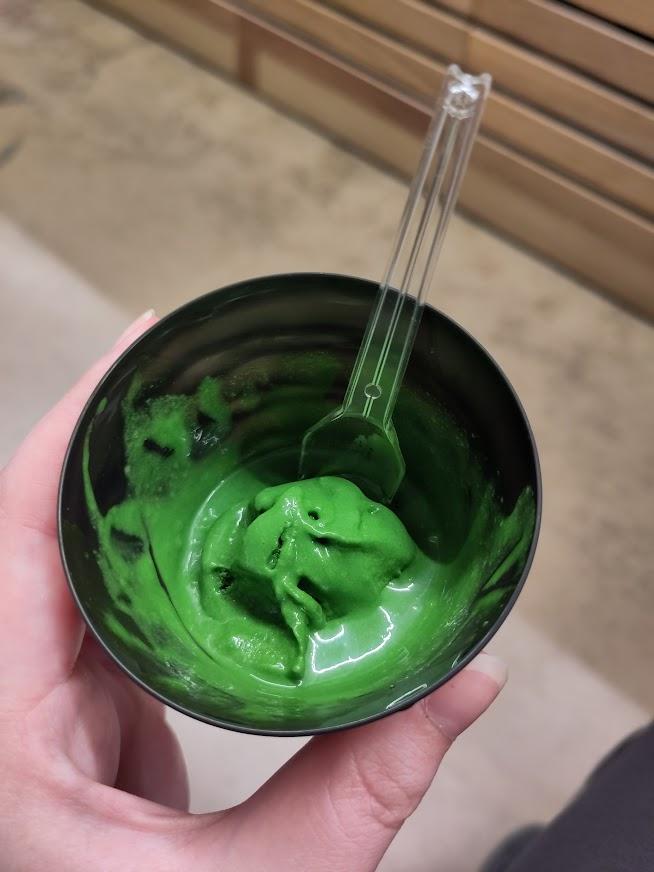
Back to Fushimi Inari
We loved our evening walking in Fushimi Inari but wanted to go back to see it in daylight and buy a few souvenirs (shops were closed on our previous visit). We were lucky to meet one of the cats living on temple grounds. We also checked places we didn’t see the other day (Fushimi Inari is so much more than just the red torii you see everywhere!).

Not far from Fushimi Inari, we went to a chopsticks store. The overall selection is similar from one chopsticks shop to another, but of courses there are local limited editions, and we found a really nice pair with a drawing of Fushimi Inari. Note it’s possible to have your chopsticks engraved, but you should go to the shop earlier enough (not later than two hours before the shop closes).
📍 Chopstick store Kyoto Fushimi ward
For some more souvenirs, we visited B-Side Label, Japanese made stickers with a lot of geeky references but also limited editions based on the place you’re at.
That was a lot to say about Kyoto! Those four days were busy, and there is still much to see in this huge city (more to come soon, as we’ll spend three more days in Kyoto during our second Japan trip).
*Prices and convertions based on those applied at the time of our visit (May-June 2023)
